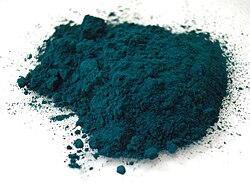 Chemical structure of one of the components of Phthalocyanine Green G | |
| Names | |
|---|---|
| Other names Phthalo green, viridian hue, pigment green 7, copper phthalocyanine green, C.I. pigment green 7, non-flocculating green G, polychloro copper phthalocyanine, and C.I. 74260, copper hexadecachlorophthalocyanine | |
| Identifiers | |
3D model (JSmol) | |
| ChemSpider | |
| ECHA InfoCard | 100.014.114 |
| EC Number |
|
PubChem CID | |
| UNII | |
CompTox Dashboard (EPA) | |
| |
| |
| Properties | |
| C32Cl16CuN8 | |
| Molar mass | 1127.15 g·mol−1 |
| Appearance | Green solid |
Except where otherwise noted, data are given for materials in their standard state (at 25 °C [77 °F], 100 kPa). | |
| Phthalo green | |
|---|---|
 Phthalocyanine green pigment | |
| | |
| Hex triplet | #123524 |
| sRGB B (r, g, b) | (18, 53, 36) |
| HSV (h, s, v) | (151°, 66%, 21%) |
| CIELChuv (L, C, h) | (19, 15, 146°) |
| Source | The Mother of All HTML Colo(u)r Charts |
| ISCC–NBS descriptor | Very dark yellowish green |
| B: Normalized to [0–255] (byte) | |
Phthalocyanine green G, which has many commercial names, is a synthetic green pigment from the group of phthalocyanine dyes, a complex of copper(II) with chlorinated phthalocyanine. It is a soft green powder, which is insoluble in water. [1] It is a bright, high intensity colour used in oil and acrylic based artist's paints, and in other applications.